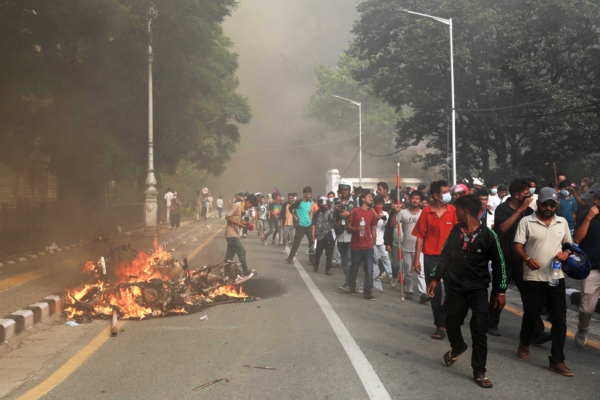The street protests in Nepal have been escalating, leading to the resignation of 73-year-old Prime Minister and Chairman of the Nepal Communist Party (Unified Marxist-Leninist) Khadga Prasad Oli. The protests stemmed from public dissatisfaction with the social media ban, but it is widely believed that the underlying reasons include frustration over high unemployment rates and government corruption. The corruption issues brought by the Chinese Communist Party’s Belt and Road Initiative have also sparked concerns.
Prior to the ban, a movement called Nepo Baby was launched on social media, exposing the lavish lifestyles of politicians’ children suspected of nepotism and corruption. After the protest turned into violent clashes, the Nepali government announced the revocation of the social media ban on September 9th. However, the discontent of the people shifted towards widespread accusations of political elite corruption. Protesters chanted slogans such as “Fight corruption, not social media” and “Youth against corruption.”
Some protesters condemned the Nepali government for mismanaging the country for decades. Corruption in the construction of the Pokhara International Airport involving tens of millions of dollars was exposed, but despite frequent instances of official corruption, few have faced judicial consequences.
Pokhara Airport is a flagship project of the Chinese Belt and Road Initiative. The airport was constructed with a $216 million loan from the China Import-Export Bank, with construction undertaken by the Chinese state-owned company CAMC Engineering. Raw materials and job opportunities were mainly monopolized by Chinese companies.
In 2013, the Civil Aviation Authority of Nepal signed an agreement with “China International” for the construction of the airport. In April 2016, the then-Nepali Prime Minister Oli laid the foundation stone for the new airport with the aim of commencing operations on July 10, 2021. However, completion was repeatedly delayed, and on August 8, 2022, the Civil Aviation Authority of Nepal officially announced that the airport would commence operations on January 1, 2023.
This once highly anticipated new international airport now sees limited international scheduled flights.
Before the end of 2023, Nepal’s anti-corruption authority, the Commission for the Investigation of Abuse of Authority, received multiple complaints about substandard quality and significant cost escalation during the construction of the Pokhara Airport and initiated an investigation.
Jay Neesang, Chairman of the Asian Institute for Diplomacy and International Affairs in Nepal, stated in an interview with Voice of America that the responsibility lies with Nepal’s senior political leaders. They allowed Chinese financing and airport construction in exchange for kickbacks. However, the investigation may be just to placate the angry public.
Vijay Kant Karna, former Nepali Ambassador and Chairman of the Center for Social Inclusion and Federalism in Kathmandu, mentioned in an interview with Voice of America that from the beginning, the Pokhara International Airport has faced criticism. People criticized Nepali political elites, especially left-wing figures, for their corrupt ties with Chinese construction companies.
Karna believed that the airport’s design itself had significant flaws, with its quality largely inadequate. Construction did not comply with environmental and social protection mechanisms.
In April 2025, the Public Accounts Committee of the Nepali Parliament released an investigation report pointing out that the airport was fundamentally substandard. It not only used inferior building materials but also faced issues of corruption and lack of supervision.
The grace period for Nepal to repay the loan to China for the Pokhara International Airport will expire in 2026. During his visit to China last year, the Nepali Prime Minister requested the loan be converted to a grant, effectively canceling the debt. However, it is unclear how the Chinese Communist Party responded.
In recent years, China has heavily invested in infrastructure projects in Nepal, covering roads, bridges, hydroelectric plants, medical facilities, and post-disaster reconstruction projects.
Another typical example of local political turmoil arising from China’s Belt and Road Initiative in recent years is Serbia. The renovation project of the Novi Sad train station undertaken by a Chinese state-owned enterprise resulted in a ceiling collapse last year, causing 16 deaths and triggering the largest anti-government protests in Serbia in decades, which continue to this day.
Sheng Xue, a prominent Chinese-Canadian writer and senior commentator, told Epoch Times that corruption in Chinese projects is not just an economic risk but can directly evolve into a political crisis. China’s former strategy of buying off small countries is crumbling: from a “century project” to a “century burden,” it may ultimately lead to diplomatic isolation and a messy debt scenario.

